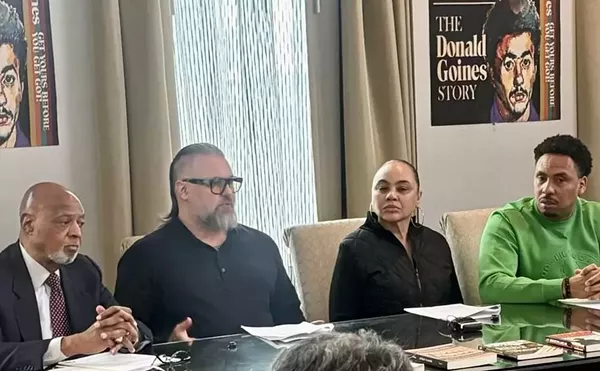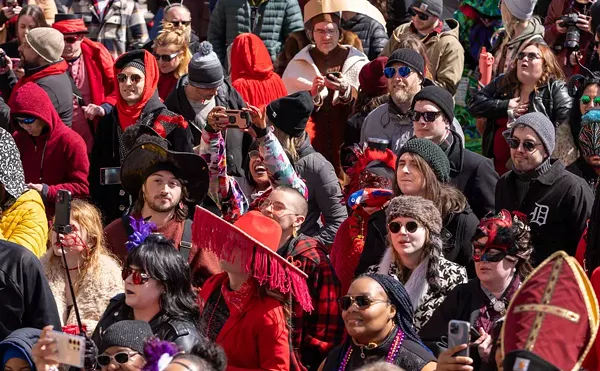He doesn't consider himself a collector, he has an extensive background in modern art, and he lives in New York City.
Meet the Detroit Institute of Art's new adjunct curator of contemporary art.
Mark Rosenthal replaces Joe Cunningham, who, about two years ago now, bailed after only a few months in Detroit. Newly appointed, Rosenthal will work with Rebecca Hart, associate curator of contemporary art, on programming and acquisitions.
A well-known writer and independent curator, Rosenthal has been a leading figure in the field for 30 years. Just scan these appointments: head of the department of 20th-century art at the Philadelphia Museum of Art, head of modern and contemporary art at the National Gallery in Washington, D.C., curator of collections at the Berkeley Art Museum in California and consulting curator to New York's Guggenheim Museum and the Norton Museum of Art in West Palm Beach, Fla.
It seems like a dig that DIA director Graham Beal decided to hire someone who lives in New York City, especially since DIA employees are typically required to live in the city proper, let alone the state. Beal says, "There is fierce competition for contemporary art curators, due to the large number of specialist institutions such as [New York's] Museum of Modern Art, San Francisco Museum of Modern Art, the Whitney and the Museum of Contemporary Art Los Angeles. Designating this position as adjunct recognizes that competition and still provides a way for the DIA to benefit from the engagement of an experienced, well-connected curator."
I guess you could look at it this way: Every art curator knows it's crucial to keep a close eye on new kids on the block. With New York as his base, Rosenthal's bringing where he lives and what he learns out here to Detroit.
Still, it's worth mentioning that Rosenthal's been hired at a time when one of the visionaries in the field will soon be a free agent. On March 20, Kathy Halbreich announced she's stepping down from her position as director at Minneapolis' Walker Art Center, as of November 2007. Under Halbreich's leadership, the Walker's curators supported emerging artists, commissioned major performing art and new music works, and showcased compelling exhibitions, including a premiere by Belgian filmmaker Chantal Ackerman.
Not that she is necessarily available or interested, but the point is that Rosenthal is a more conservative choice for the museum. (Halbreich perhaps would make a better fit at a place like MOCAD, Detroit's new contemporary art institution, currently seeking a director. Matter of fact, on Tyler Green's blog, Modern Art Notes, Halbreich says she's looking for "a different kind of institution" ... something "smaller.") Metro Times spoke with the DIA's new curator briefly about his upcoming plans. Time will tell, even if Rosenthal won't (yet), what he has in store.
Metro Times: When curating for a recognized institution of the size and caliber of the DIA, how big a role does the character of the city play in contemporary exhibition programming and acquisitions? Are efforts made to first appeal to a national audience or local audience?
Mark Rosenthal: Curators wear many hats, but the DIA is an international institution with an encyclopedic point of view. If you try organizing a "major" exhibition that involves borrowing works from all over the world, you don't persuade somebody that they should lend it to you because it's the first time that show will ever be done in Detroit. The way you persuade them is with an exhibition of historic and international importance. That's why you lend things too.
My activities, or anybody's activities at the museum, address the national or international audience, of course. But the recent history of acquisitions shows that there is a consciousness of who the population of Detroit is, if not the region. There's been a good deal of buying of African-American and African art. Plus, the museum has an African art curator, which isn't so common. But I don't think a museum should or ought to cater to any one audience.
MT: What role are institutions supposed to play in showing local artists' work? Do you see that the DIA has any responsibility there in either acquiring or exhibiting local artists' work?
Rosenthal: I absolutely think it has a responsibility, but I don't think it's the only one. I come back to the audience: Does the Detroit audience want to see Detroit artists or do they want to see international artists? The audience might say, "Well, we see Detroit artists every day in all the local venues, and we hope the DIA would bring us what the world has to offer."
Most institutions try to balance it. I was the curator of modern and contemporary in Philadelphia and we did a certain amount of shows of local artists, and we bought to some extent. I'm sure in the process, we didn't make anybody happy. Those with special interests let it control how they view what's happening, but the general audience doesn't start with a preconceived agenda.
MT: Some of the recent shows at the DIA, such as the Ansel Adams and Annie Leibovitz exhibits, are safe contemporary choices. I'd like the contemporary department to bring in shows that I wouldn't expect. Can you explain what you would offer that might energize the department?
Rosenthal: If you're asking what shows I'll plan, it's too early. But, you know, I'm always shocked and amazed that the things that seem like clichés, or familiar in the mind's eye, are that way because they are so fantastic. When I meet someone who's never been to the Grand Canyon and they say they think it wouldn't be anything of a surprise, I say, "You have no idea." Although it seems trite, every day of the year, one hundred thousand people stand there with their jaws open. I like to think what I do will be edgy, but I also want to show artists that have fabulous reputation for a reason.
MT: I'm a fan of South African artist and filmmaker William Kentridge and the Spanish trickster Juan Muñoz. I've noticed you've worked on shows with both of them. Can you explain what attracts you to certain artists or styles?
Rosenthal: Here's the long way of answering it. I'm an art historian, I wrote my dissertation on Paul Klee once upon a time and, in the beginning, I didn't know much about contemporary art, I was mostly involved in early modern — I wrote articles about Picasso, did an exhibition on the German expressionist Franz Marc. I want to bring a sense of history to bear on looking at contemporary art. I like to think I'm being tougher and more discriminating about projects in contemporary art because I'm choosing what I believe will stand the test of time. The other thing about being a curator is that you really can't work on that many things at once, every project takes years.
MT: So the "test of time" refers to contextualizing contemporary art in the historical tradition, but also, simply, the work is something you've got to look at for a while and not get disgusted with.
Rosenthal: You have to believe in it. Two years in, if you don't believe in it, boy, you've wasted a lot of time. I like to work with artists who I find supreme, or there's something dramatic there, where I'm just the little guy standing in awe. Kentridge's body of work is that way to me. [Anselm] Kiefer's body of work was that way to me.
MT: What do they have that mesmerizes you?
Rosenthal: I felt like in some ways, the show of my lifetime was my abstraction show, from Kandinsky to the present. I only bring it up because it's unlike work by Muñoz or Kentridge. I'm usually weary of art that has a heavy psychological component because I worry that it will be too literary. Unless it has the visual punch, it just isn't art.
I can tell you that the one medium that feels very much "of the moment" is installation. It has such far-reaching consequences: First of all, it's being practiced all over the world. In an amazing way, it has become the lingua franca. Artists from anywhere can now relate to each other in the sense of what they are achieving with their medium.
MT:Why do you think that is? Does it have to do with "living in art"?
Rosenthal: Absolutely. Painting is more a language of Western society. But also, installation, which is inherently very theatrical, is a walk-in work of art. You experience it in real time. Plus, so much of what an installation has happening is real, whether it's real animals, real sky above your head — like a James Turrell.
MT: It's also an older tradition.
Rosenthal: Yes, it's the Lascaux caves and the Sistine Chapel ceiling. It's always been around.
MT: Do you have a wish list for shows or acquisitions?
Rosenthal: I need to dig more into the collection, but I'm aware a little bit. The museum could use more of the Germans, like Kiefer, Polke and Richter, for instance. A wonderful Jasper Johns and Cy Twombly. In Florida, where you've reached me, we just bought a photographic work by Jeff Wall who I think is fantastic, and it was almost by luck because the big show just opened at MOMA, everyone is clamoring to get one. I know the dealer and was able to reserve one. I hadn't been thinking about it previously, but there it was.
The history of museums and collecting involves more accidents than deliberation. MOMA wound up with three Jasper Johns out of their first show because the director got to the opening and was so impressed by this young artist, he managed to buy three works. That's sort of the "great story" in museum circles about going with the courage of your convictions.
Rebecca Mazzei is the arts editor of Metro Times. Send comments to [email protected]





